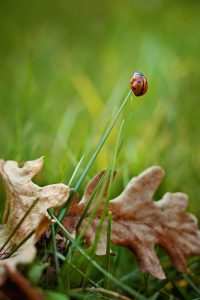As children, we learn to think of insects as bad guys, home invaders that we must squash on sight. We carry this perception into the garden and assume that all bugs are bad guys that should be blasted with chemicals on sight. While some garden insects are definitely destructive, there’s another group of “beneficial insects” that help us by eating the destructive insects and maintaining a natural balance in the garden.
Unfortunately, the broad-spectrum insecticides that are used to kill the bad guys, will kill the good guys too! Their use will actually intensify the problem by removing the beneficial insects that would help keep those bad guys in check. Perhaps we can change our thinking, and take a closer look before reaching for that broad-spectrum insecticide.
Ladybugs and Wasps
No doubt the most recognizable beneficial insect is the Ladybug (or Lady Beetle). Both larvae and adults eat small insects. They eat up to 40 aphids an hour and eat bean thrips, beetle grubs, scale insects, spider mites, whiteflies, and insect eggs. Also easily recognized, but rarely considered helpful is the “yellow jacket” wasp. Wasps are great predators of caterpillars, including tomato hornworms. If dinner is too big to carry in one trip, a wasp will butcher it and carry it back to the nest piece by piece! Fruit growers, however, should discourage wasps’ help since they’ll attack fruit as enthusiastically as hornworms.
Centipedes and Fireflies
Centipedes tend to gross us out and send us screaming, but they’re busy in the garden, compost, and leaf pile hunting down all sorts of insects. If you stumble upon them ugh, cover them quick(!), but leave them to their work. Firefly larvae eat slugs and ground-dwelling, soft-bodied insects, while the adults entertain us with tiny light shows. Although we would never intentionally kill a firefly, remember that generalized spraying could do just that.
Lacewings and Parasitic Wasps
Lacewings are less well known but extremely helpful. Small, pale green and fragile looking, they produce killer larvae that feed on aphids, mites, scale insects, whiteflies, thrips, and the eggs of caterpillars. Parasitic wasps help us by injecting their eggs into host insects. The resulting larvae grow by absorbing nourishment through the skin and, subsequently, killing the host – yeow!
Nematodes
Beneficial nematodes are a microscopic garden ally. When watered into the lawn or garden bed, they search out and destroy the larvae of Japanese beetles and the grubs that love to destroy our lawns. Once introduced into an area, they’ll work for up to two years. Beneficial nematodes and beneficial insects are sold in garden centers for release into your home landscape. Be patient, it takes 2-5 weeks for them to become established and make an obvious impact.
Planting Flowers Can Help Beneficial Insects
Help support your beneficial insect population by planting pollen and nectar-rich flowers like alyssum, dill, fennel, and lobelia and perennials like daisies, ajuga, bee balm, lavender, veronica, sedum, yarrow, sea lavender, and solidago. Alyssum makes a great edging in a sunny garden while lobelia does the same for the shade. Dill and fennel have lacy foliage that mixes beautifully with other plantings and both excel as culinary herbs. Thyme, lavender, and all of the perennials listed are among today’s most popular plants. That makes it easy to plant what you like while accommodating the beneficial insects!
Finally, avoid using toxic sprays or dusts in the garden. Even botanical insecticides (pyrethrums, neem oil, etc.) can kill some beneficial species, so use them sparingly. Beneficial insects may not be a quick fix, but they are an important part of a natural, balanced and self-sustaining system that will ultimately, work better for you and for the environment!